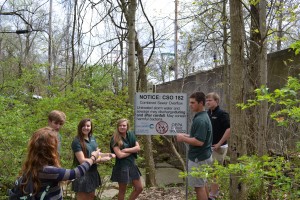Mapping Watersheds

Originally appears in the Spring 2015 issue
The age-old art of cartography has evolved from ancient manually made paintings on parchment to the interactive digital mapping technology found on pocket size smartphones today. As a tool, maps have helped humans denote political boundaries, identify natural resource reserves, interpret weather, and of course, travel. In the field of Conservation Biology, scientists are using maps as a communication and empowerment tool, giving voice to communities whose land may be threatened by development or natural resource exploitation. Community or participatory mapping includes recognition of the spaces and resources being used and valued in an area, but by incorporating the unique perspectives of its participants, it can also help people discover, express and define their connection and interaction with a place. This collective awareness and connection can then be used to identify and defend that which should stay and that which needs to change.
This article describes a project designed to utilize mapping as an educational tool by empowering high school students’ voices and their understanding of scientific content. This inquiry-based, experiential activity is multidisciplinary and incorporates many cross-curricular skills. In this activity students use math when calculating an area or drawing a scale, social studies as they discover the historical use of land and resources on campus, and art, technology, and communication to document and creatively express their findings.
To view the photo-rich magazine version, click here.
If you are not already a subscriber, please subscribe to read the full article
Lauren Wulker is a high school science educator in Cincinnati, Ohio and wrote this article as part of her Master’s work with Miami University’s Global Field Program. Lauren is an urban farmer and local advocate for sustainable solutions in the places we work, live, and play.
References and Resources
Chambers, R. (2006). Participatory mapping and geographic information systems: Whose map? Who is empowered and who dis-empowered? Who gains and who loses? The Electronic Journal on Information Systems in Developing Countries, 25, 1-11.
Hart, R. (2007). “Mapping and modeling” From Children’s Participation: The Theory and Practice of Involving Young Citizens in Community Development and Environmental Care. Chpt. 12, pp. 165-171.
Mears, J. (2012). The many benefits of community mapping. Connect, 25 (4), 1-3.
Rainforest Foundation UK. (2011, November 1). How to Map, Part 1: Mapping for Rights Retrieved from https://www.youtube.com/watch?v=qRhYktaBWYg.
Rocheleau, D. (2005). Maps as power tools: Locating communities in space or situating people and ecologies in Place? From Brosius, J.P., Tsing, A.L. and Zerner, C. (eds.), Communities and Conservation. New York, NY: Altamira Press. Chapter 13, pp. 327-362.
Leave a Reply
You must be logged in to post a comment.





